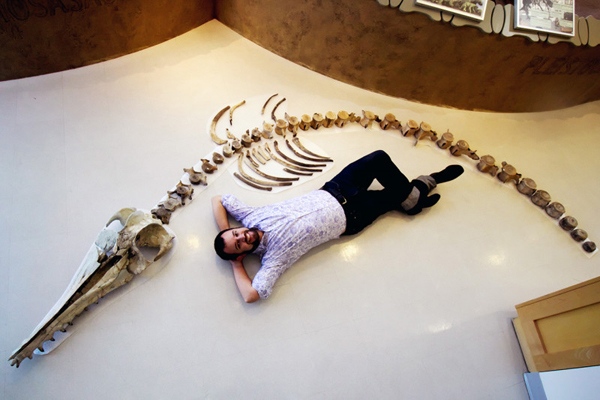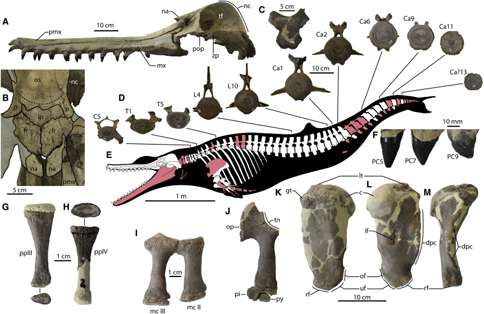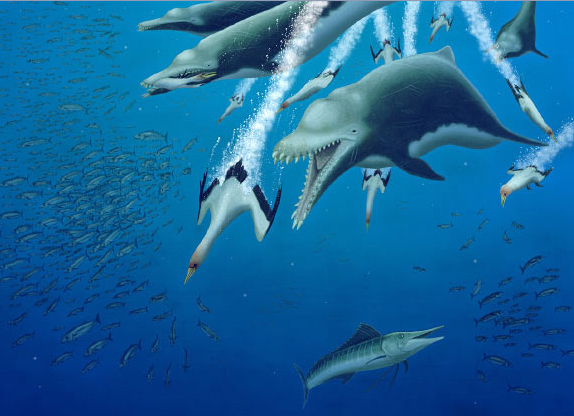Deadly Dolphin Predator of the Oligocene Epoch
Well-preserved Skeleton Provides Information on Evolution of Toothed Whales
The well-preserved fossilised remains of a large cetacean from the coastal low country of South Carolina is helping palaeontologists to better understand the evolution of rapid locomotion in toothed whales. The specimen, which is nearly complete (cranial material, plus most of the spine and the remains of one flipper), was found in the early 1990s by Mark Havenstein, a commercial palaeontologist and a former student at the College of Charleston in South Carolina. The skeleton was later acquired by a private fossil collector before being donated to the Mace Brown Museum of Natural History at the College.
Dangerous Prehistoric Dolphin
Writing in the academic journal “Current Biology”, a team of researchers led by Robert W. Boessenecker (Department of Geology and Environmental Geosciences, College of Charleston), have identified it as a large, predatory dolphin which shows adaptations within its skeleton to permit fast swimming.
Palaeontologist Robert W. Boessenecker Poses with the Fossil Material

Picture credit: College of Charleston/Robert Boessenecker
Extant cetaceans are superbly adapted to a marine existence, with tail flukes a key evolutionary innovation in propulsion, an adaptation shared by all living species. Some dolphins, for example, have been recorded swimming at speeds in excess of 50 km/h (27 knots). These fast speeds and bursts of acceleration are attributed to the thrust provided by the powerful tail fluke with flippers providing steering. These movements are enabled by a sturdy and powerful body with a relatively rigid torso consisting of numerous compacted vertebrae and movement in the water is adjusted by varying the angle of the flippers.
The Rarity of Oligocene Cetacean Skeletons
Eocene-aged cetaceans reveal a transition from a semi-aquatic lifestyle to a fully aquatic one with adaptations to permit a nektonic habit. However, the rarity of Oligocene whale skeletons has hampered the efforts of palaeontologists to understand how the evolution of tail fluke-powered, but forelimb-controlled locomotion came about. The newly named Ankylorhiza tiedemani, which had previously only been known from a partial rostrum, represents a transitional form in terms of its forelimb shape and structure. Its forelimb is intermediate in morphology between stem cetaceans and living whales, whereas its axial skeleton displays incipient rigidity at the base of the tail with a flexible lumbar region.
Ankylorhiza tiedemani Probably Occupied an Apex Predator Niche
Picture credit: Robert Boessenecker
Commenting on the importance of the South Carolina specimen, lead author Robert Boessenecker explained that the discovery was one of the first skeletons found of a very early member of the toothed whales (Odontoceti), shortly after they diverged around 35-36 million years ago from baleen whales (Mysticeti).
He added:
“What makes that important is its evolutionary position as a very early branching dolphin. Most early dolphins are known only from skulls, so having a skeleton with flippers and most of the vertebrae gives us an unprecedented look into the evolution of swimming adaptations. That unprecedented window surprisingly told us that baleen whales and dolphins have many similarities owing to convergent evolution since their evolutionary split 35 million years ago.”
“Fused Roots”
The scientists estimate that Ankylorhiza grew to about 4.8 metres in length and probably occupied a similar predatory role in marine environments as modern orcas do today. The genus name means “fused roots” and refers to the strongly fused tooth roots.
A phylogenetic assessment places Ankylorhiza near to the base of the toothed whale radiation and if this is the case, than it implies that several adaptations to aid locomotion such as a shortened humerus and a narrow but powerful peduncle (the end of the body that is adjacent to the fluke), evolved independently in both the Odontoceti and the Mysticeti. In essence, that there is evidence to support the theory of convergent evolution in locomotor features between toothed and baleen whales.
The Fossil Material and a Skeletal Outline of Ankylorhiza tiedemani

Picture credit: Boessenecker et al (Current Biology)
A Prehistoric Dolphin with Primitive and Derived Characteristics
Ankylorhiza’s skeleton shows a combination of more derived as well as primitive features, thus helping to cement it as a basal member of the toothed whale lineage.
Robert Boessenecker stated:
“These primitive features are surprising because palaeontologists and biologists long assumed that many of the adaptations for rapid swimming in baleen whales and toothed whales were ancient adaptations shared thanks to their common heritage over the past 35 million years.”
Everything Dinosaur acknowledges the assistance of a press article from the College of Charleston in the compilation of this article.
The scientific paper: “Convergent Evolution of Swimming Adaptations in Modern Whales Revealed by a Large Macrophagous Dolphin from the Oligocene of South Carolina” by Robert W. Boessenecker, Morgan Churchill, Emily A. Buchholtz, Brian L. Beatty and Jonathan H. Geisler published in Current Biology.
The user-friendly Everything Dinosaur website: Everything Dinosaur.


